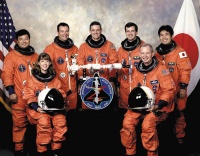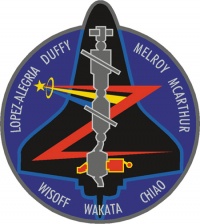STS-92
From The Space Library
 | |
| Organization | NASA-Office of Space Flight (United States) |
|---|---|
| Mission type | Human Crew |
| Launch date | October 11, 2000 |
| Launch vehicle | Space Shuttle |
| Launch site | Cape Canaveral, United States |
| COSPAR ID | 2000-062A |
| Experiments | Here |
| Alternate Names | 26563 |
| Additional Information | Here |
| Data Collection | Here |
| Payload Mass Up | 12704.66 kg |
STS 92 was an American shuttle spacecraft that was launched from Cape Canaveral at 23:17 UT. The crew carried out space walks to install a 8.5 ton, aluminum Z-1 truss on the Unity module. The truss was intended to support a football-field sized solar array that will be installed during a later mission in December 2000. A triaxial attitude control gyroscope and a Ku-band satellite dish were then installed on the truss. The crew also installed a major 1.2 tonne docking port named Pressurized Mating Adapter (PMA) on the Unity module. They fired thrusters in the shuttle to raise the altitude of the ISS. Among other activities was a practice run of a device named SAFER (Simplified Aid For EVA Rescue) to rescue an untethered astronaut and to assess whether a dead or gravely ill spacewalker could also be retrieved back to a shuttle or the ISS. The shuttle landed in Edwards AFB in California on 24 October at 20:59 UT. A Cape Canaveral landing had to be cancelled because of persistent bad weather in southern Florida. The potential uses of the ISS for furthering science and engineering are outlined in a NASA site, http://spaceflight.nasa.gov/station/science/ STS 92 was the 100th shuttle mission, almost coinciding with the 100th successful launch of the European Ariane rocket.

